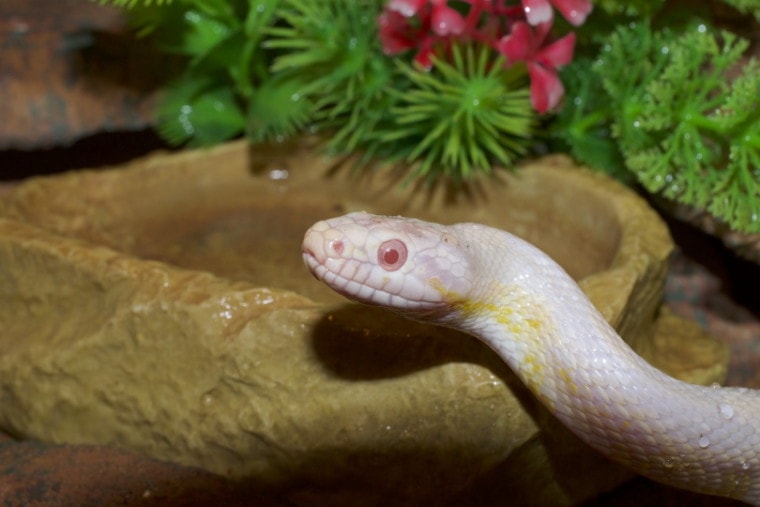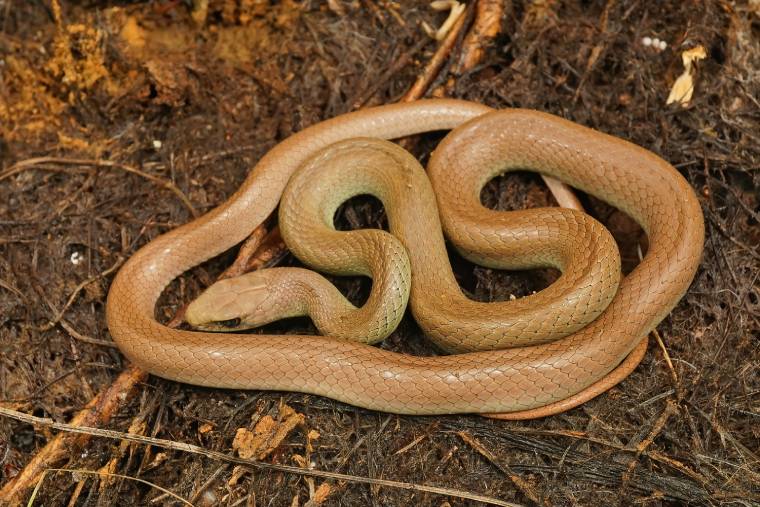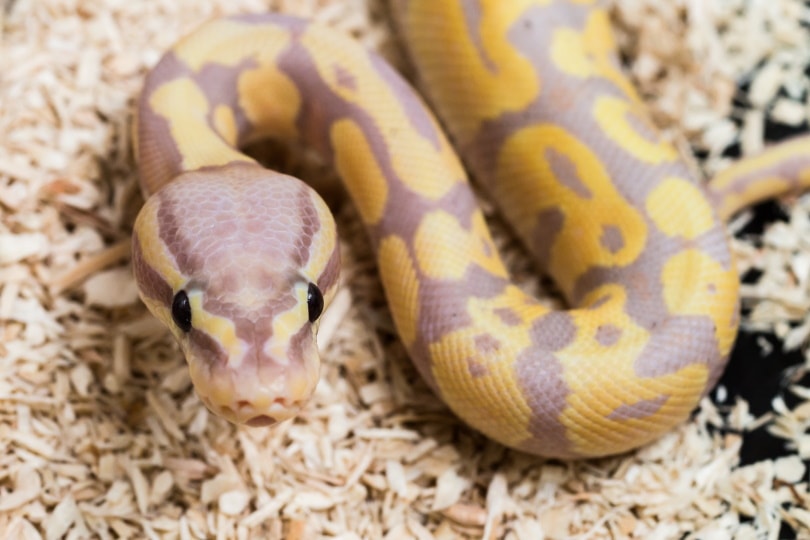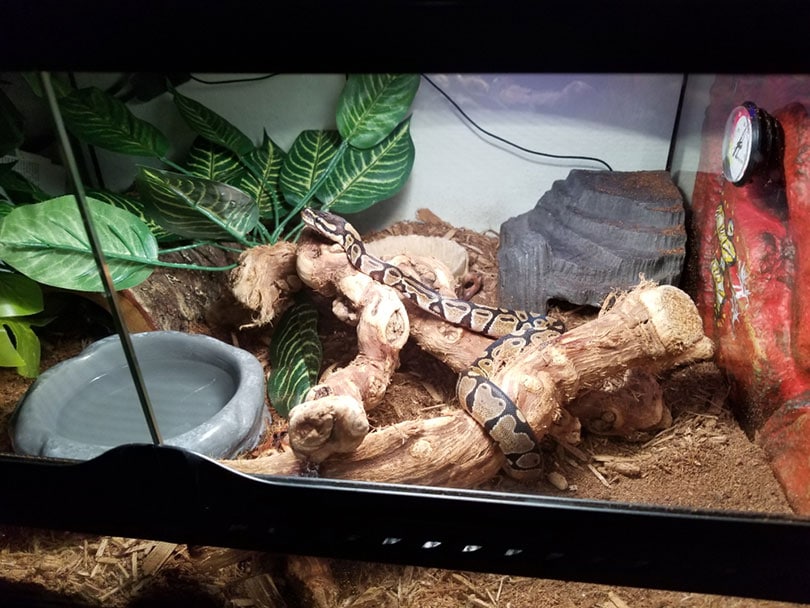
Reptiles are becoming increasingly popular in the United States thanks to increased captive breeding that allows these fascinating animals to come into our homes. Albino Corn Snakes are one of the most sought-after snakes because of their striking appearance, active lifestyle, and ease of maintenance. If you are interested in owning one of these unique breeds, keep reading while we take a deep dive into the Albino Corn Snake so you can see if it’s right for your home.

Quick Facts About the Albino Corn Snake
| Species Name: | P. guttatus |
| Common Name: | Albino Corn Snake |
| Care Level: | Beginner |
| Lifespan: | 15 – 20 years |
| Adult Size: | 4 – 5 feet |
| Diet: | Mice, rats |
| Minimum Tank Size: | 20-gallon tank |
| Temperature & Humidity: | 75–85 degrees Fahrenheit 65%–75% humidity |
Do Albino Corn Snakes Make Good Pets?
The Albino Corn Snake is non-venomous and suitable for children. It’s extremely adaptable and doesn’t seem to mind living in captivity, plus, it’s not hard to create a living space for it. It’s active, fun to watch, and gets quite large, sometimes reaching more than 4 feet long. It has a simple diet and doesn’t mind being handled.
Appearance
As you might have guessed from the name, the Albino Corn Snake has a lack of pigmentation that gives them a light color, but they are not white like you might be expecting. This snake will usually have red and orange saddle markings on its back. These saddle markings will often have a white border, and you may also see some yellow around the head. The belly will be mostly white but may also have some red. It has a slender body and can grow as long as 5 feet.

How to Take Care of Albino Corn Snakes
Habitat, Tank Conditions & Setup
Tank
Your Albino Corn Snake is extremely versatile and can survive happily in a standard 20–40 gallon aquarium with a screened lid, so it doesn’t escape. However, a larger aquarium is better, especially if the snake is larger than 4 feet.
Lighting
You will not need special lighting for your Albino Corn Snake. Ordinarily, we use UVB light to keep the snake warm, but this lighting can damage the sensitive eyes of your albino snake.
Heating (Temperature & Humidity)
Temperature
Your Albino Corn Snake will need temperatures to stay between 75–85 degrees F. Since you shouldn’t use heat lamps, you will need to use a ceramic or carbon heater to keep the temperatures within acceptable limits.
Humidity
You will need to keep the humidity between 65% and 75% humidity, especially when your pet is shedding its skin, to help make the process easier. Since the temperature is high, frequent misting with an ordinary water bottle should be all that is required. Use an ergometer for accurate readings.
Substrate
Since your Albino Corn Snake requires high humidity, most experts suggest using a substrate type that helps retain it. Coconut fiber is a perfect example, and your pet will love it. A layer of leaf clippings, or leaf litter, on top of the substrate will also help retain moisture while giving your pet a fun place to explore.
Tank Recommendations
| Tank Type: | 40-gallon glass vivarium |
| Lighting: | Standard lighting |
| Heating: | Heating pad/tape on the bottom of the enclosure |
| Best Substrate: | Coconut fiber, leaf litter |

Feeding Your Albino Corn Snake
Your Albino Corn Snake is a carnivorous animal that will primarily eat mice and rats. Since it doesn’t have venom, it will constrict its prey, much like the ball python. You will likely purchase pre-killed or frozen mice to feed your snake so it can remain healthy. It will get all of the nutrients it needs from eating these rodents whole, so it doesn’t need much supplementation. However, some owners will occasionally dust the mice with calcium and vitamin D3 supplements to help replace some of the nutrients it misses from not getting enough sunlight.
Diet Summary
| Fruits: | 0% of diet |
| Insects: | 0% of diet |
| Meat: | 100% of diet – small/medium-sized mice |
| Supplements Required: | Calcium, vitamin D3 |

Keeping Your Albino Corn Snake Healthy
Your Albino Corn Snake is generally a healthy species that usually live more than 15 years with minimal effort. It enjoys climbing, so keep plenty of branches and twigs in the aquarium to climb on and leaf litter for it to dig through to keep it mentally stimulated.
Common Health Issues
Parasites
Internal parasites are the most common health problem for Albino Corn Snakes, but feeding pre-killed captive grown mice significantly reduces the risk of parasite infestation. These parasites are why you shouldn’t feed your pet wild-caught animals.
Mouth Rot
Mouth rot is an infection of the mouth caused by an injury, poor environment, and more. Symptoms of mouth rot include thick mucus possibly containing blood coming from the mouth. You may also see puss that looks like cottage cheese or a swollen mouth. If you notice these symptoms, it will be time to take your snake to the vet.
Lifespan
The lifespan of your Albino Corn Snake is usually 15–20 years, with some living even longer than that. It’s not quite as long as the ball python, which can live 30 years or more, but it’s still longer than most dogs and cats. Maintaining a habitat with the proper temperature and humidity is the best way to help your snake reach its maximum lifespan.
Breeding
The Albino Corn Snake is a naturally occurring morph of the standard corn snake. However, genetics causes the pigment not to show on these and will also cause them to have red eyes sensitive to light. These snakes are unique in that the albinism only blocks melanin, but the red colors can still show, which is why the snake is usually red, orange, and yellow.

Are Albino Corn Snakes Friendly? Our Handling Advice
To handle your Albino Corn Snake, start slow and careful and keep the handling sessions to only a few minutes at a time, but let your snake calm down before returning it to the habitat so it can learn the routine. Then, as the snake gets used to you, you can extend your sessions slightly every few days.
Shedding & Brumation: What to Expect
Your Albino Corn Snake will shed every few weeks, and when it does, you will want to make sure you increase the humidity in the tank to make It easier for your snake to remove the skin. Providing plenty of rough surfaces like tree branches and rocks will give your pet something to rub on to help dislodge the skin.
Brumation is a type of hibernation that occurs in snakes as the temperatures drop. As long as you keep the temperature in the correct zone, you should not need to worry about brumation, and your pet will stay active year-round.
How Much Do Albino Corn Snakes Cost?
You can expect to pay between $40 and $100 for your Albino Corn Snake, depending on where you live and what breeder you choose. Since these snakes are getting increasingly popular, there is a good chance that you can find a breeder near you, which will allow you to avoid shipping costs.
Care Guide Summary

Conclusion
The Albino Corn Snake makes an excellent first pet for children and is a great way to get started raising reptiles for adults as well. Lack of pigment gives it an attractive pattern that stands out against the background and will look good in any home. It’s an active snake that’s fun to watch and has a fairly long lifespan. You don’t need any special lighting, and the habitat is easy to maintain.
We hope you have enjoyed our look into these increasingly popular snakes and have learned something new. If we have convinced you to get one for your home, please share this guide to the Albino Corn Snake on Facebook and Twitter.
Featured Image Credit: aixklusiv, Pixabay








